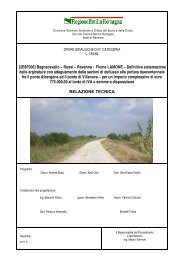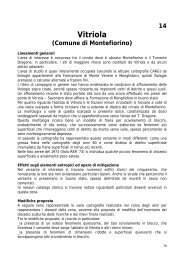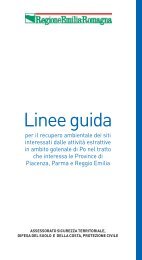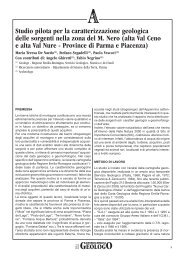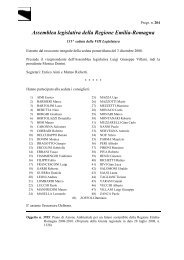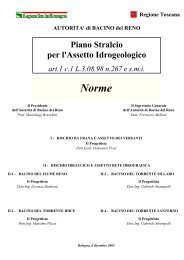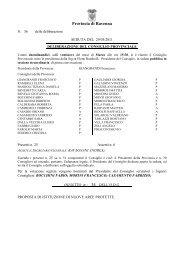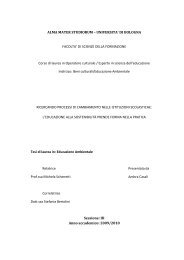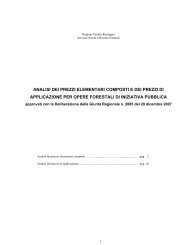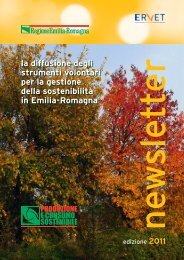air, water and soil quality qualité - ER Ambiente - Regione Emilia ...
air, water and soil quality qualité - ER Ambiente - Regione Emilia ...
air, water and soil quality qualité - ER Ambiente - Regione Emilia ...
Create successful ePaper yourself
Turn your PDF publications into a flip-book with our unique Google optimized e-Paper software.
cooperative enterprises; Sovkhoz were governmental companies, extended in the<br />
order of thous<strong>and</strong>s hectares, hierarchically managed by Soviet agronomists.<br />
New cotton fields were irrigated thanks to a myriad of irrigation channels,<br />
diverting great <strong>water</strong> volumes from Amu-Darya <strong>and</strong> Syr-Darya. The cotton<br />
production of Soviet Central Asia grew sensibly, but it never exceed the American<br />
one. Unfortunately, this project had a terrible impact on the environment in general<br />
<strong>and</strong> on the hydrological balance in particular.<br />
Starting from the ’60s of the 20 th century, a decade after the beginning of<br />
Kruscev’s new agrarian approach in Central Asia, the consequences of this<br />
program, at first weakly, then brutally, arose. Deprived of the <strong>water</strong> contribution of<br />
its tributaries, the Aral Sea started a fast regression, because the inflow of the Amu-<br />
Darya <strong>and</strong> Syr-Darya rivers could not balance the evaporation. This shrinking did<br />
not shock Soviet technicians; on the contrary, as a logic result of the increase of the<br />
irrigated area, they had forecasted this process, defining it as a «necessary<br />
sacrifice» for the growth of the Nation (RUM<strong>ER</strong>, 1989). In the last 40-45 years the<br />
sea level shrank for more than 20 meters; the area <strong>and</strong> the <strong>water</strong> volume decreased<br />
of 75% <strong>and</strong> 90% respectively (fig. 2). This process, hidden for a long time by<br />
Soviet authorities <strong>and</strong> spread to the world community only between the ’80s <strong>and</strong><br />
the ’90s (MICKLIN, 1988; ELLIS, 1990; REZNICHENKO, 1992), was so intense that<br />
in 1989-1990 the Aral Sea divided into two separated <strong>water</strong> bodies: the Small Aral<br />
Sea (also called North Aral Sea), fed by the Syr-Darya river <strong>and</strong> entirely settled in<br />
Kazakhstan, <strong>and</strong> the Large Aral Sea (also called South Aral Sea), fed by the Amu-<br />
Darya river <strong>and</strong> shared between Kazakhstan <strong>and</strong> Uzbekistan, at that time Republics<br />
of the Soviet Union.<br />
The Aral Sea fast regressive trend caused a long series of environmental problems.<br />
Because of the reduction of the sea level, <strong>water</strong> salinity grew enormously, passing<br />
from 10 g/l to 160 g/l nowadays verifiable in some areas, changing most of the<br />
Aral from a brackish basin to a hyperaline one. This transition produced serious<br />
repercussions from an ecological point of view, inducing at first the extinction of<br />
local ichthyofauna, artificially replaced by exotic species; then a reduction in<br />
number of the last ones. The Syr-Darya <strong>and</strong> Amu-Darya deltas have undergone an<br />
involution from wetl<strong>and</strong>s to arid zones; in the so-called Priaralye (Aral Sea<br />
region), ground<strong>water</strong> table sank, contributing to <strong>soil</strong> salinization <strong>and</strong><br />
desertification. The Aral Sea shrinking also triggered climate change on a regional<br />
scale: without the mitigation of the <strong>water</strong> body, the climate accentuated its<br />
continental characteristics, suffering hotter <strong>and</strong> drier summers <strong>and</strong> colder winters<br />
than usual. Moreover, whereas the Aral Sea disappeared, the dried bottom of the<br />
<strong>water</strong> body, made up of saline deposits <strong>and</strong> pollutants collected by the rivers of the<br />
basin, is now exposed to wind erosion, causing health problems (in particular<br />
cancers) to local communities. Last but not least, the regressive trend nearly caused<br />
a further splitting of Large Aral into a Western Large Aral <strong>and</strong> a Eastern Large<br />
Aral (Glantz, 2007).<br />
<br />
54



